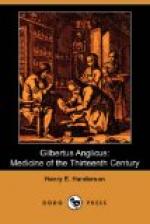Now Roland, in his edition of Roger’s “Chirurgia,” criticises both of these statements of his master, as follows:
Nota quod quamvis Rogerius dicat quod apponatur albumen ovi, non approbo, quia frigidum est naturaliter, et vena et nervus et arteria frigida sunt naturaliter, et propter frigiditatem utrorumque non potest perfecte fieri consolidatio.
And again:
Nota quod secundum Rogerium nervus omnino incisus non potest consolidari, vel conjungi nec sui. Nos autem dicimus quod potest consolidari et iterum ad motum reddi habillis, cum hac cautela: Cauterizetur utrumque caput nervi incisi peroptime cum ferro candenti, sed cave vulneris lobia cum ferro calido tangantur. Deinde apponantur vermes contusi et pulveres consolidativi, etc.
It will be observed that Gilbert, in spite of the rejection by Roland of the egg-albumen dressing of Roger, still recommends its use in wounds of the neck, and although he professes to have seen many nerves regenerated (consolidari) under the simple angle-worm treatment of his master, he still makes no mention of the painful treatment of divided nerves by the actual cautery, so highly praised by Roland. It would seem, therefore, that Gilbert was not familiar with the writings of Roland when his Compendium was written, or he would, doubtless, not have omitted so peculiar a plan of treatment in an injury of such gravity. As Roland’s edition of Roger’s “Chirurgia” is said to have been written in 1264, the comparison of these passages would seem to indicate that Gilbert must have written the Compendium after 1230 and prior to the year 1264.
Gilbert’s surgical chapters discuss the general treatment of wounds and their complications, and more specifically that of wounds of the head, neck, throat, wounds of nerves, of the oesophagus, scapula, clavicle, of the arm, the stomach, intestines and the spleen; fractures of the clavicle, arm, forearm and ribs; compound fractures; dislocations of the atlas, jaw, shoulder and elbows; fistulae in various localities, and the operations on the tonsils and uvula, on goitre, hernia and stone in the bladder, etc.—certainly a surgical compendium of no despicable comprehensiveness for a physician of his age and country.
In the general treatment of wounds (f. 86 c) Gilbert tells us the surgeon must consider the time, the age of the patient, his temperament (complexio) and the locality, and be prepared to temper the hot with the cold and the dry with the moist. Measures for healing, cleansing and consolidation are required in all wounds, and these objects may, not infrequently, be accomplished by a single agent. The general dressing of most wounds is a piece of linen moistened with the white of egg (pecia panni in albumine ovi infusa), and, as a rule, the primary dressing should not be changed for two days in summer, and for three days in the winter. In moist wounds vitreolum




